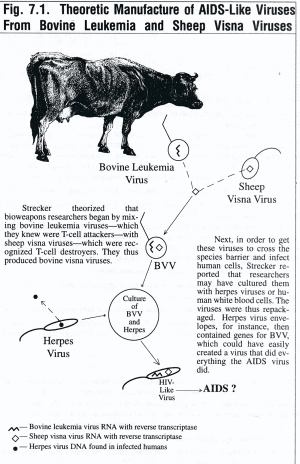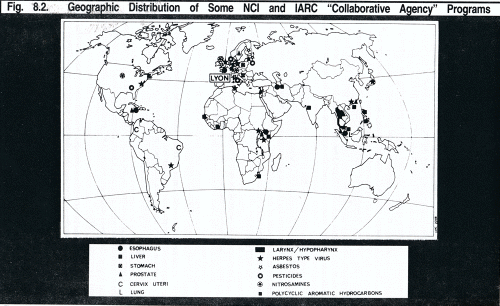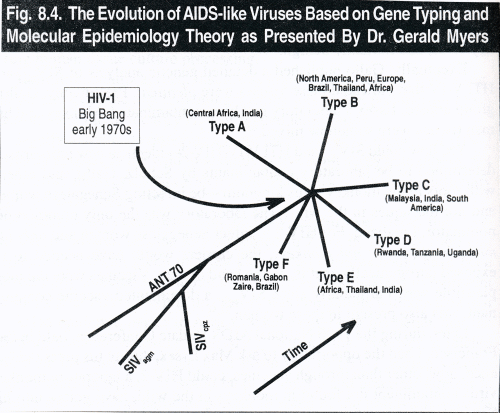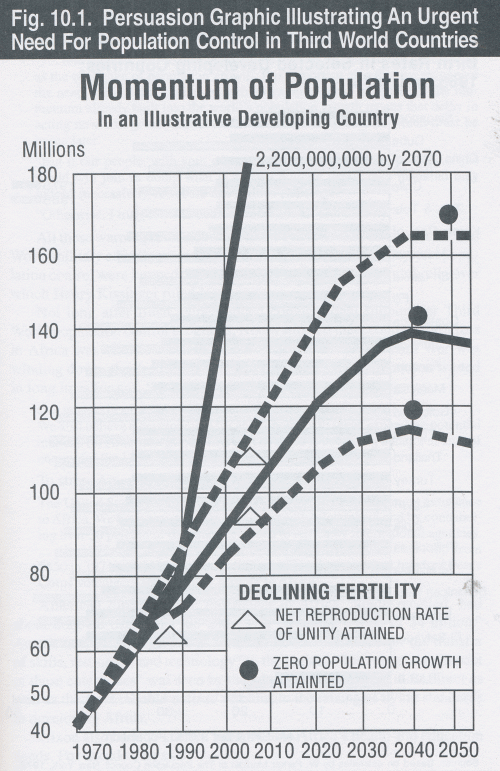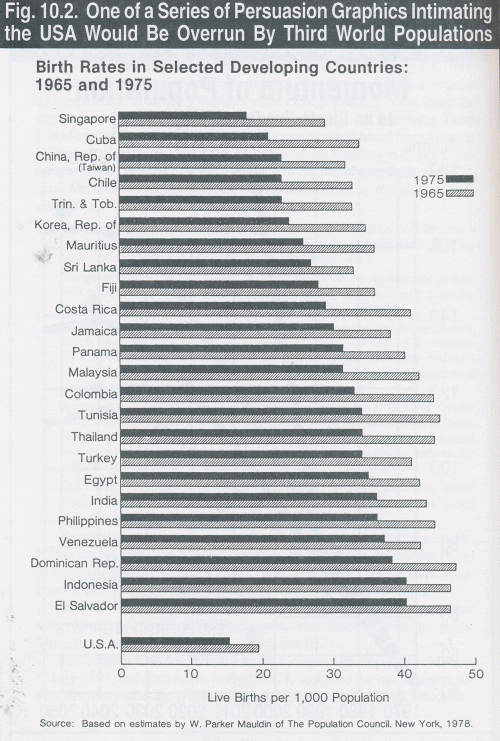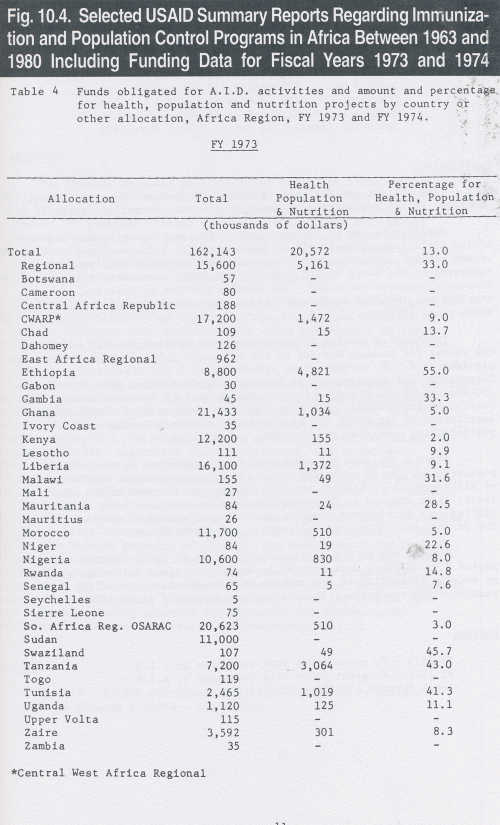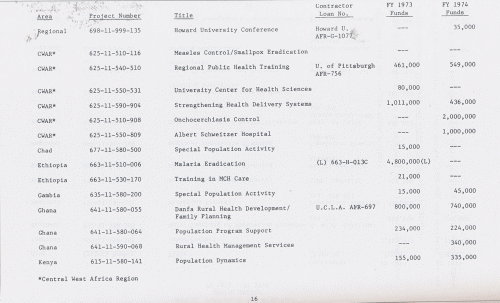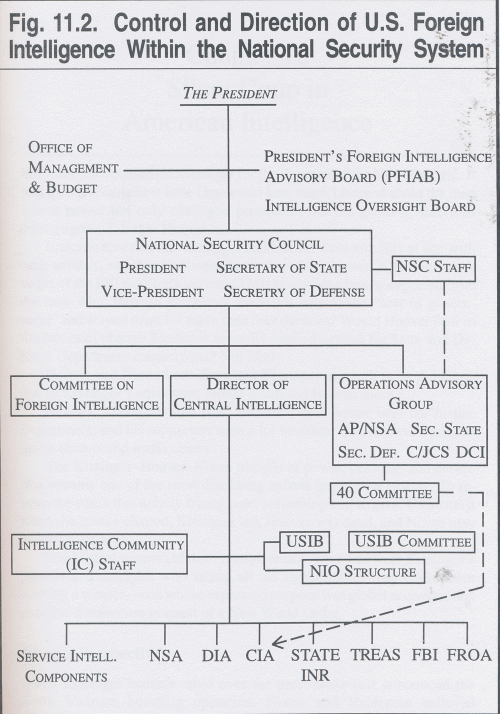Fig 6.7 - Major United States Army Biological Weapons Contractors for Fiscal year 1969
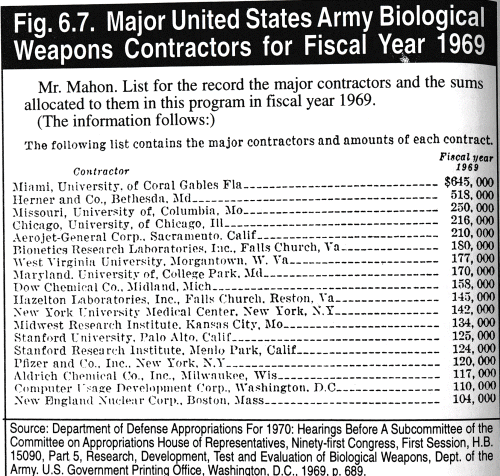
Mr. Mahon. List for the record the major contractors and the sums allocated to them in this program in fiscal year 1969.
(The information follows:)
The following list contains the major contractors and amounts of each contract.
Contractor / Fiscal year 1969
Miami, University of Coral Gables Fla / $645,000
Herner and Co., Bethesda. Md / $518,000
Missouri, University of, Columbia, Mo / $250,000
Chicago, University, of Chicago, Ill / $216,000
Aerojet-General Corp,. Sacramento, Calif / $210,000
Bionetics Research Laboratories, Inc., Falls Church, Va / $180,000
West Virginia University. Morgantown, W. Va / $177,000
Maryland. University of, College Park. Md / $170,000
Dow Chemical Co., Midland, Mich / $158,000
Hazelton Laboritories, Inc., Falls Church, Reston. Va / $145,000
New York University Medical Center, New York, NY / $142,000
Midwest Research Institute. Kansas Clty, MO / $134.000
Stanford University, Palo Alto, Califf / $125,000
Stanford Research Institute, Menio Park, Califf / $124,000
Pfizer and Co., Inc., New York, NY / $120,000
Aldrich Chemical Co., Inc., Milwaukee, Wis / $117,000
Computer Usahe Development Corp., Washington, D.C. / $110,000
New England Nuclear Corp., Boston, Mass / $104,000
Source: Department of Defense Appropriations For 1970: Hearings Before A Subcommittee of the Committee on Appropriations House of Representatives, Ninety-first Congress, First Session, H.B. 15090, Part 5, Research, Development, Test and Evaluation of Biological Weapons, Dept. of the Army. U.S. Government Printing Office, Washington, D.C., 1969, p689.
Fig 6.8 - The Early Research of Cr. Robert Gallo at the National Cancer Institute and it's Implications in relation to the Theory of synthetic HIV Development
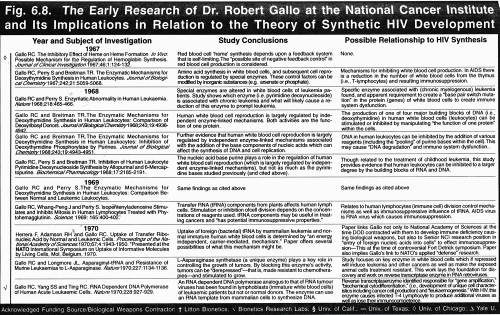
Year and Subject of Investigation / Study Conclusions / Possible Relationship to HIV Synthesis
1967
Gallo RC. The Inhibitory Effect of Heme on Heme Formation In Vivo. Possible Mechanism for the Regulation of Hemoglobin Synthesis. Joumal of Clinical Investigation 1967;46;1:124-132. / Red blood cell 'heme' synthesis depends upon a feedback syslem thaf is self-limiting. The "possible site of negative feedback control" in red blood cell production is considered. / None.
Gallo RC, Perry S and Breitman TR. The Enzymatic Mechanisms for Deoxythymidine Synthesis in Human Leukocytes. Journal of Biological Chemistry1967;242;21:5059-5068. / Amino acid synthesis in while blood cells, and subsequent cell reproduction is regulatted by special enzymes. These control factors can be modfied by inorganic substances (e.g. arsenate or phosphate). / Mechanisms for inhibiting white blood cell production. In AIDS there is a reduction in the number of white blood cells from the thymus (i.e., T-lymphocytes) and resulting immunosuppression.
1968
Gallo RC and Perry S. Enzymatic AbnormaIity in Human Leukaemia. Nature 1968;218:465-466. / Special enzymes are altered in white blood cells of leukemia patients. Study shows which enzyme (i.e. pyrimidine deoxynucleoside) is associated with chronic leukemia and what will likely cause a reduction of this enzyme to prompt leukemia. / Specific enzyme associated with (chronic myelogenous) leukemia found, and apparent requirement to create a "base pair switch mutation" in the protein (genes) of white blood cells to create immune system dysfunction.
Gallo RC and Breitman TR.The Enzymatic Mechanisms for Deoxythymidine Synthesis in Human Leukocytes: Comparison of Deoxyribosyl Donors. Journal of Biological Chemistry1968;243;19:4936- 4942. / Human while blood cell reproduction is largely regulated by independent enzyme-linked mechanisms. Both activities are the function of one protein. / The production of one of four major building blocks of DNA (i.e., deoxythymidine) in human white blood cells (leukocytes) can be stimulated or inhibied by manipulating "the function of one protein" within the cells.
Gallo RC and Breitman TR.The Enzymatic Mechanisms for Deoxythymidine Synthesis in Human leukocytes: Inhibition of Deoxythymidine Phosphorylase by Purines. Journal of Biological Chemistry 1968;243;19:4943-4951. / Further evidence that human white blood cell reproduction is largely regulated by independent enzyme-linked mechanisms associated with the addition of the base components of nucleic acids which can affect the synthesis of DNA and cell replication. / DNA in human leukocytes can be inhibited by the addition of various reagents (including the "pooling" of purine bases within the cell).This may cause "DNA degradation" and immune system dysfunction.
Gallo RC, Perry S and Breitman TR. Inhibition of Human Leukocyte Pyrimidine Deoxynucleoside Synthesis by Allopurinal and 6-Mercaptopurine. Biochemical Pharmacology1968; 17:2185-2191. / The nucleic acid base purine plays a role in the regulation of human white biood cell reproduction(which is largely regulated by independent enzyme-linked mechanisms), but not as much as the pyrimidine bases studied previously (and cited above). / Though related to the treatment of childhood leukemia, this study provides evidence that human leukocytes can be inhibited to a larger degree by the building blocks ot RNA and DNA.
1969
Gallo RC and Perry S.The Enzymatic Mechanisms for Deoxythymidine Synthesis in Human Leukocytes: Comparison Between Normal and Leukemic Leukocytes. / Same findings as cited above. / Same findings as cited above.
Gallo RC, Whang-Peng J and Perry S. Isopentenyladenosine Stimulates and Inhibits Mitosis in Human Lympocytes Treated with Phytohemagglutinin. Science. 1969: 165:400-402. / Transfer RNA (tRNA) components from plants affects human lymph cells. Stimulation or inhibition of cell divisIon depends on the concentrations of reagents used. tRNA components may be useful in treating cancers and "has potential immunosuppressive properties." / Relates to human lymphocytes (immune cell) division control mechanisms as well as immunosuppressive influence of tRNA. AIDS virus is RNA virus which causes immunosuppression.
1970
Herrera F, Adamson RH and Gallo RC. Uptake of Transfer Ribonucleic Acid by Normal and Leukemic Cells. Proceedngs of the National Academy of Sciences. 1970;67;4:1943-1950. Presented at the NATO International Symposium on Uptake of Informative Molecules by Living Cells, Mol, Belgium, 1970. / Uptake of foreign (bacterial) tRNA by mammalian leukemia and normal immature human white biood cells is detennined by "an energy independent, carrier-mediated, mechanism." Paper offers several possibilities of what this mechanism might be. / Paper links Gallo not onty to National Academy of Sciences at the time DOD contracted with them to develop immune deliciency causing biological weapons, but also to Senior NCI research position in "entry of foreign nucleic acids into cells" to effect immunosuppression -- This at the time of controversial Fort Detrick symposium. Paper also implies Gallo's link to NATO's applied "defense" research.
Gallo RC and Longmore JL. Asparaginyl-tRNA and Resistance of Murine Leukaemias to L-Asparaginase. Nature 1970;227:1134-1136. / L-Asparaginase synthetase (a unique enzyme) plays a key role in controlling the growth of tumors. By blocking this enzyme's activity, tumors can be "derepressed"- that is, made resislantto chemotherapies -- and stimulated to grow. / Study focuses on key enzyme in white blood cells which itfrepressed will induce leukemia and other cancers as well as make the exposed animal cells treatment resistant. This work lays the foundation for discovery and work on reverse transcriptase enzyme in RNA retroviruses.
Gallo RC, Yang SS and Ting RAC. RNA Dependent DNA Polymerase of Human Acute Leukaemic Cens. Nature 1970;228:927-929. / An RNA dependent DNA polymerase analogus to that of RNA tumour viruses has been found in lymphoblasts (immature white blood cells) of leukaemic patients but not or normal donors. The enzyme can use an RNA template from mammalian cells to synthesize DNA. / Reverse transcriptasenzyme identified responsible for "gene amplification, "biochemical cytodifferentiation," (i.e., development of unique cell characteristics including cancer cell production) and "leukaemogenesis." With HIV, this enzyme causes infected T-4 Lymphocite to produce additional viruses as well as lose their immunocompetence.

Year and Subject of Investigation / Study Conclusions / Possible Relationship to HIV Synthesis
1972 continued
Talal N and Gallo RC. Antibodies to DNA:RNA Hybrid in Systemic Lupus Erythematosus measured by a Cellulose Ester Filter Fadioimmunoassay. Nature New Biology 1972;24:240-242. / "The RNA tumour viruses apparently replicate by means of an RNA-dependent DNA polymerase (reverse transcriptase) that produces virus specific DNA which presumably is integrated into the host genome. The first product of this process is a DNA:RNA hybrid...Antibodies to such hybrids might strengthen the role for viruses in this disease." / Gallo and Talal concluded that -- "A continued search for antibodies to natural hybrids seems warranted." The importance, specificity and difficult task of isolating antibodies to reverse transcriptase RNA tumor viruses descriped in this report, provided the incentive to develop the antibody isolation techniques and antibodies which AIDS researchers throughout the world sought from Gallo alone.
Borrow SN, Smith RG, Reitz MS and Gallo RC. Stimulated Normal Human Lymphocites Contain a Ribonuclease-Sensitive DNA Polymerase Distinct from Viral RNA-Directed DNA Polymerase. Proceedings National Academy of Sciences 1972;69;11:3228-3232. / Ribonuclease-sensitive DNA synthesis was found in normal human blood lymphocites stimulated with the foreign plant derived antigenic substance called phytohemagglutinin (PHA), but not in the unstimulated lymphocites. DNA polymerase purified from this fraction does not transcribed specific regions of "naturally occurring, exogenously supplied single-stranded RNA," that is the "70S RNA from RNA tumor viruses." This distinguishes this enzyme from the RNA-directed DNA polymerase (reverse transcriptase) found in cancer causing RNA viruses and human leukemic cells. / In this study, Gallo and co-workers experimented with the single stranded RNA from chicken viruses which were known to cause leukemia in the birds. They essentially injected the single strands of RNA into the human white blood cells to see if the normal DNA enzymes present in the lymphocites would be able to work with the viral RNA to produce a radioactively labeled protein. This study shows that by the early 1970s Gallo was injecting foreign single stranded RNA from animal viruses to determine their effects on human white blood cell structure and functioning. The AIDS virus, as you may now know, is a single stranded RNA retrovirus which as shown in this study, provides an enzyme mechanism foreign to the cell's natural protein synthesis mechanism in order to produce protein, that is, reproduce itself.
Gallo RC, Abrell JW, Robert MS, Yang SS and Smith RG. Reverse Transcriptase From Mason-Pfizer Monkey Tumor Virus, Avian Myeloblastosis Virus, and Rauscher Leukemia Virus and Its Response to Rifamycin Derivatives. Journal of the National Cancer Institute 1972;48;4:11:1185-1189. / The partially purified polymerases from RNA tumor viruses exhibited similar characteristics which enabled the virus' "reverse transcriptases" to be distinguished from the purified cellular enzymes. "Since the existence of RNA-dependent DNA polymerase (RDDP) was first reported, RDDP has been found in all RNA tumor viruses. Included in this class are the following 3 viruses: Mason-Pfizer monkey tumor virus (M-PMTV), avian myeloblastosis virus (AMV), and Rauscher Murine (rat/mouse) leukemia virus (RLV). M-PMTV is of interest, since it is a primate RNA virus adapted to a human cell line, NC-37. This cell line was initially derived from the peripheral blood of normal human lymphocytes. This system has been used in our laboratory as a model for the detection of the RDDP in human neoplastic cells. The data also demonstrated the ability of the viral and not naturally occurring enzymes to utilize single-stranded RNA for protein synthesis which may be increased dramatically by the incorporation of thymidylic acid and adenylic acid. / Here, Gallo and coworkers publish experiments using monkey leukemia viruses as well as chicken and mouse viruses to test for their effects on normal human DNA-directed protein synthesis in white blood cells. Many authorities believe the AIDS virus bears great similarities to the simian monkey virus with which Gallo's lab was also working (See Fujioka and Gallo, 1971; and Gallo, Miller, Saxinger and Gillespie, 1973). In addition, the researchers acquired additional evidence that as previously noted some amino acids, in this case, thymidylic and adenylic, can greatly increase the rate of RNA reverse transcriptase directed DNA synthesis when added to the "synthetic DNA-RNA hybrid." This aspect of the study reflects the minute detail which went into influencing the expression of foreign (in this case monkey virus) RNA on human white blood cells.
Wu AM, Ting RC, Paran M and Gallo RC. Dordycepin Inhibits Induction of Murine Leukovirus Production By 5-lodo-2'-deoxyuridine. Proceedings of the National Academy of Sciences 1972;69;12:3820-3824. / "RNA tumor viruses replicate via a transcription of proviral DNA ... The discovery of RNA-dependent DNA polymerase ... supports the idea that the genetic information of RNA tumor viruses can exist in an infected cell (or transformed cell) in a form of DNA termed a "provirus." In this study, "the production of RNA viruses induced by 5-iodo-2'-deoxyuridine, IdU, (a constituent of RNA) in [mouse/rat] cell lines" was blocked by a chemical (Cordycepin 3'-deoxyadenosine), a known inhibitor of poly (A) (this term refers to a chemical polymer of adenylic acid which is a condensation product of adenosine and phosphoric acid; a nucleotide found within all nucleic acids). / In the above study, Gallo et al found that adenylic acid a basic (nucleotide) component of RNA and DNA can "greatly increase the rate of RNA directed protein synthesis from DNA through teh reverse transcription mechanism. In this study they concluded that chemicals which can block the adenylic acid portion of viral RNA can inhibit this protein synthesis/viral reproduction mechanism, though not without side effects. In regard to HIV synthesis, in this study new forms of RNA retroviruses were being synthesized by the addition of 5-iodo-2'-deoxyuridine, that is IdU, a foreign RNA component introduced into normal rodent white blood cells. Clearly, the researchers were manufacturing a new strain of virus here and checking to see if chemotherapy could stop it from reproducing itself through the reverse protein synthesis mechanism typical of RNA retroviruses.
Gallo RC, Hecht SM, Whang-Peng J and O'Hopp S. Ns-(∆2-Isopentenyl) Adenosine: The Regulatory Effects of a Cytokinin and Modified Nucleoside From tRNA on Human Lymphocytes. Biochimica Et Biophysica Acta 1972;281:488-500. / Ns-(∆2-Isopentenyl) Adenosine, a plant hormone (among a class of hormones called cytokinins known to be a "causative agent in certain plant pathogens or cancers and component of the tRNAs of numerous forms of plant and animal life") was found within the tRNA of lymphosarcoma cells from cancer patients at levels "four times as great as that in normal lymphocytes" from healthy humans. "DNA synthesis cannot be the primary site of action" of this drug which causes "remarkably similar effects" as phytohemagglutinin on "stimulated lymphocytes at comparable concentrations." / Gallo's group is clearly considering the possibility of using Ns-(∆2-Isopentenyl) Adenosine or related plant hormones to both inhibit and stimulate cancer cell division, they appear at this point to have narrowed their attention on to the tRNA segments composed of adenosine or adenylic acids.
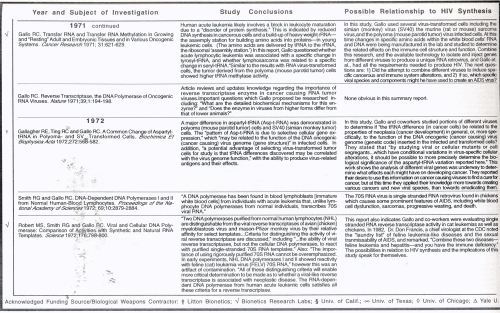
1972 continued
Ting RC, Yang SS and Gallo RC. Reverse Transcriptase, RNA Tumour Virus Transformation and Derivatives of Rifamycin SV. Nature New Biology 1972;236:163-165. / Derivatives of the antibiotic rifamycin derived lrom bacteria were used to inhibit the effects of rat and mouse leukaemia-sarcoma viruses preventing the formation of cancer cells. "This suggests that reverse transcripase is necessary for transformation by RNA tumour viruses. / Reverse transcriptase, the unique enzyme found in HIV is here shown to be required lor leukaemia and sarcoma viruses to produce their cancer causing effects. HIV attacks white blood cells, that is leukocytes, and causes a rare skin cancer known as Kaposi's sarcoma.
Smith RG, Whang-Peng J, Gallo RC, Levine P and Ting RC. Selective Toxicity of Rifamycin Derivatives for Leukaemic Human Leucocytes. Nature New Biology 1972;236:166-171. / Certain rifamycin derivatives have been lound to be more toxic lor fresh human leukaemic blood cells than for normal blood cells. These particular antibiotics also inhibit the reverse transcriptases of both human and viral origin. / This work advanced the use of certain antibiotics in an effort to fight human leukemia. Though it bears no relationship to the development of HIV or other AIDS-like viruses, it might be interpreted as having contributed to the development of chemotherapies for cancer as well as possibly AIDS patients. The authors did indicate that normal cells would also be harmed along with cancer cells.
Gallo RC. RNA-Dependent DNA Polymerase in Viruses and Cells: Views on the Current State. Blood 1972;39:1 :117-137. / The presence of an RNA-dependent DNA polymerase or reverse transcriptase has been found in every RNA oncogenic virus ... It is assumed thet the role of the enzyme is to convert viral 70S RNA to a DNA copy, allowing the viral genome to be inserted into the host cell. / Though this summary and update report on reverse transcriptase and its link to cancer bears no relationship to the development of HIV or other AIDS-like viruses, Gallo did discuss beginning to develop antibodies which could help detect this enzyme which is currently used to identity HIV infections.
1973
Gallo RC. Reverse Transcriptase and Neoplasia. Biomedicine 1973;18;446-452. / "Reverse transcriptase, the DNA polymerase of type-C RNA tumor viruses, can be distinguished Irom the DNA polymerases of normal cells by biochemical and immunological approaches. The enzyme is required for formation of the provirus, the RNA tumor viruses, and hence, for inlection of cells by these viruses ...A reverse transcriptase related to the reverse transcriptase of type-C RNA tumor viruses (leukemia-lymphoma-sarcoma complex) has been unequivocally demonstrated in some human acute leukemic cells and its presence has been suggested ...in other human cancers ...Work on reverse transcriptase has contributed to major progress in tumor virology and to molecular biology in general in a very short period." / This review article summarizes Gallo's research on the unique reverse transcriptase enzyme associated with HIV and other RNA tumor viruses. Here the theory of how HIV and other such viruses replicate is published -- ten years belore Luc Montagnier at the Pasteur Reseach Instiute isolated HIV from the white blood cells of AIDS patients. The biochemical and immunological detection techniques which would later be used to detect HIV infection were also discussed here. It is remarkable thaI the type-C RNA tumor viruses Gallo studied and discussed here produced a similar complex of diseases associated with AIDS including a "leukemia-lymphoma- sarcoma complex."
Wu AM, Ting RCY and Gallo RC. RNA-Directed DNA Polymerase and Virus-Induced Leukemia in Mice. Proceedings of the National Academy of Sciences 1973;70;5:1298-1302. / "The results of this study suggest that RNA-directed DNA polymerase is essential lor induction of leukemia by exogenous virus and correlate with the previous observation that the same [Rifamycin antibiotic] derivatives block viral transformation (in cell cultures]. / Besides unon Bionetics, a documented U.S. D.O.D. biological weapons contractor, being cited as the major funding source for these experiments. The Special Virus Cancer Program from Hazleton Laboratory in Vienna,Va. was mentioned as the supplier of Rausher leukemia viruses used in this study. This is noteworthy as Hazleton's Reston Va, monkey facility was the site of the sfrightening Ebola-like virus outbreak in December, 1989. Nowhere in Richard Preston's best seller The Hof Zone was Hazleton mentioned as an actual supplier of RNA tumor viruses. In fact, Preston alleged the deadly viruses came from either the Phillipines or Africa.
Paran M, Gallo RC, Richardson LS and Wu AM. Adrenal Corticosteroids Enhance Production of Type-C Virus Induced by 5-lodo-2'-Deoxyuridine from Cultured Mouse Fibroblasts. Proceedings of the National Academy of Sciences 1973;70;8:2391-2395. / RNA tumor viruses can be stimulated to reproduce in mouse cells by the addition of adrenal corticosteroids and many other hormones. Cordycepin (a crystalline antibiotic obtained from the bacteria Cordyceps militans) was shown to be an inhibitor of RNA synthesis in RNA tumor viruses. / No apparent relation to the development of AIDS-like viruses or of identification or treatment methods for AIDS. Paper does provide interesting acknowledgment: The cordycepin antibiolic used in the experiment had been obtained from the "Drug Development Branch of the National Cancer Institute." The NCI, the authors wrote received the drug from "Merck and Co., Incorp." Document provides evidence of link between Gallo, the NCI, and the documented biological weapons contractor Merck and Co. Also, apparent is connection of Merck and Co. to a special branch of the NCI responsible for the development of new pharmaceuticals, developed apparently with federal and taxpayer assistance.
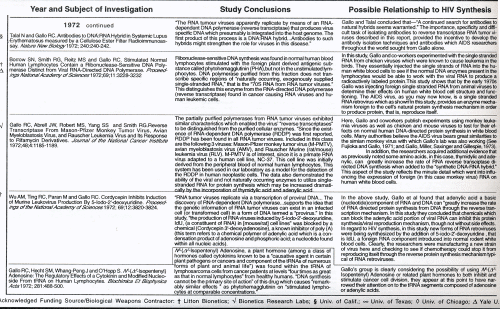
1973 continued
Gillespie D. Gillespie S. Gallo RC, East JL and Dmochowski L. Genetic Origin of RD114 and Other RNA Tumour Viruses assayed by Molecular Hybridization. Nature New Biology 1973;224:52-54. / The group tested "RNA from RD 114 virus. potentially an RNA tumour virus of human origin," to see if reverse transcription occurred to give rise to additional RD 114 virus. This study concluded that "the reverse transcriptase of RD114 is not closely related to any tested viral reverse transcriptase. It is believed that the gsl antigen of tumour viruses is species specific ... Unless it is shown that one species can produce only one type of gs1 antigen, however, it can always be argued that RD114 is a new cat virus with a gs1 antigen that differs from the antigen found on the viruses of known feline origin. Also. it was noled that "only viruses which had been grown in the orignal tumour cell and had never been purified as a cell free extract before the final colleclion hybridized [that is joined] strongly and specifically to cell DNA. / Many researchers believe that the RD114 virus evolved from a cat virus to later infect humans. This repen stated that: "Some experiments have been reported which have led to the belief that RD114 is not a cat origin or is likely to be of human origin." Just as Gallo's research team argued in this paper, "it can always be argued that the" HIV evolved as a simian virus with antigens (foreign proteins which prompt an immune response] that differ "from the antigen found on the viruses of known" monkey origin. Also, the group concluded thet "RNA tumour viruses maintained in tissue culture [as opposed to a cell line in culture] often do not produce the pathology of the original virus and give cause for questioning the indiscriminate use of the viruses transferred from one type of cell to another: Apparently, the group was not concerned about creating new viruses; rather that the new viruses they created would not mutate to other less deadly forms before they could capture and study them thoroughly.
Gallo RC, Miller NR, Saxinger WC and Gillespie D. Primate RNA Tumor Virus-like DNA Synthesized Endogenously by RNA-Dependent DNA Polymerase in Virus-like Particles from Fresh Human Acute Leukemic Blood Cells. Proceedings National Academy of Sciences 1973;70; 11:3219-3224. / "DNA polymerase activity in human acute leukemia is recovered from a cytoplasmic subcellular fraction having a density (1.16-1.17g/ ml) characteristic of RNA tumor virus particles of animals ...the purified enzyme uses synthetic template-primers with a specificity like RNA-dependent DNA polymerase [reverse transcriptase] of viruses and different from the major DNA polymerases of normalproliferating leukocytes; and ...the DNA synthesized [within the cells] by RNA-dependent DNA polymerase contained among its sequences a high proportion (50%) capable of hybridizing to RNA isolated from a primate type-C sarcoma virus and/or a murine sarcoma virus [that is, a Kirsten (rat) sarcoma-leukemia virus complex] ...The DNA-synthesizing activity was recovered in a particle not disaggregated [that is, not broken apart or destroyed] by physical manipulation unlike the vast majority of cytoplasmic particulate material, which had a density of 1.16-1.17g/ml...The present results stress the importance of purification of the cytoplasmic particle to obtain a suitable DNA probe, [thati s, a particle which can initiate the invasion of normal DNA by foreign viral RNA]. / Here in the Proceedings of the National Academy of Sciences, Gallo and co-workers proclaim they have isolated a virus-like particle from human acute [that is, quick acting] leukemic [white] blood cells. This particle they state has a specfic density of 1.16-1.17 g/ml, can be repeatedly recovered without being destroyed by physical handling, and has the capability of producing the principal rapidly progressing cancers associated with AIDS including leukemias, sarcomas, and carcinomas. In essence, Gallo and company announced isolating AIDS-like virus particles more than a decade before Luc Montagnier announced the discovery of LAV [HIV]. It is also interesting to note that to accomplish this result, Gallo and co-workers reported here using several types of RNA tumor viruses including: "SiSV (NRK)- simian [monkey] sarcoma virus grown in normal rat kidney (NRK) cells; MuSV (Kirsten [type])-a [rat/mouse) sarcoma-leukemia virus complex grown in NRK cells which originated by repeated infection of rats with a Gross-type murine leukemia virus; ...AvLV (ANV), avian [bird] leukosis (leukemia] virus, strain avian myeloblastosis [bone marrow cancer]; ...FeSV (Gardner), feline [cat] sarcoma-leukemia virus, ..." and several other RNA animal viruses.
1974
Wu AM and Gallo RC. Interaction between Murine Type-C Virus RNA-Directed DNA Polymerases and Rifamycin Derivatives. Biochimica et Biophysica Acta 1974;340;419-436 / Similar to those reported previously. / None more apparent than above.
1985
Fisher AG, Collalti E, Ratner L, Gallo RC, Wong-Staal F. A molecular clone of HTLV-III with biological activity. Nature 1985;316;262- 265. / "A clone containing the full-length HTLV-III proviral DNA was inserted into a plasmid [a extrachromosomal hereditary determining replicating unit other than a gene from the cell nucleus] and used to transfect cord blood T cells from normal newborn humans ...this molecular clone is infectious ...and causes marked cytopathic [cell death] on T-cell cultures ..." / This paper along with Gallo's earlier publication (see Gallagher, Ting and Gallo, 1972) shows that Gallo not only had the methods and materials needed to clone Luc Montagnier's LAV, but also the capacity to develop a foreign germ capable of infecting normal newborn human cells with the genetic material needed to cause marked T-cell death; identical to the AIDS virus.
Ratner L, Haseltine W, Patarca R, Livak KJ, Starcich A. and Gallo RC et al. Complete nucleotide sequence of the AIDS virus, HTLV-III. Nature 1985;313;277-284. / The complete genetic building block sequence of two human T-cell leukaemia type III (HTLV-III) proviral DNAs are identified and described. / As Strecker reported in 1986, this large group of researchers including Gallo found the HTLV family of retroviruses similar but not identical to the bovine leukaemia virus (BLV).

1970 continued
Gallo RC and Pestka S. Transfer RNA Species in Normal and Leukemic Human Lymphoblasts. Journal of Molecular Biology. I970;52:195-219. / This study identified the transfer RNA responsible for the production of every amino acid in human tissues. It found al least 56 species of tRNA from both normal and leukemic cells. Most species were very similar except for tyrosyl-tRNA and glutaminyl-tRNA where the differences were "most prounounced." / Report focused on defining specific alterations in tRNA responsible for "abnormal cellular regulatory mechanisms in neoplastic cells." Such findings would provide knowledge as to where a tRNA molecule might need to be modified (by a virus) to produce leukemia and perhaps other cancers.
1971
Gallo RC, Sarin PS, Allen, PT, Newton WA, Priori ES, Bowen JM and Dmochowski L Reverse Transcriptase in Type C Virus Particles of Human Origin. Nature New Biology. 1971;232;140-142. / Discovery of reverse transcriptase activity in hunan type C virus associated with lymphoma. By adding a synthetic RNA and Feline (i.e., cat) leukaemia virus "template" to the human virus, the rate of DNA production (and subsequenf provirus synthesis) increased two and thirty times respectively. This human "type C virus" possesses a DNA polymerase (reverse transcriptase) which can utilize both endogenous (i.e., its own natural) RNA, or "exogenous RNA" as a template, (i.e.,foreign RNA extracted from other cells or viruses) to produce the effects on the human cells coded for by the new genetic material. / Report stated this type of virus may cause many types of cancers besides leukaemia and lymphoma including sarcomas. HIV causes sarcoma development. "Only one virus [of 27 known RNA retroviruses] which contains reverse transcriptase," article said. "does not seem to be oncogenic (cancer-causing)."-- the "simian" (monkey) virus. This contradicts the claim that a monkey virus was a natural precursor to HIV. Evidence presented here that this humanly benign retrovirus was being modified by the addition of cat leukaemia RNA, and other synthetic products to increase its DNA output and protein systhesis; that is. its disease causing capacity.
Gallo RC, Whang-Peng J and Adamson RH. Studies on the Antitumor Activity, Mechanism of Action, and cell Cycle ENacts of Camptothecin. Journal of the National Cancer Institute. 1971 ;46;4:789-795. / At lower ooncentrations, dibutyryl adenosine cyclic 3',5'-monophosphate increased DNA synthesis and the rate of cell division of normal human lymphocytes responding to the stimulant phytohemagglutinin (PHA) -- a foreign plant derived substance. At higher concentrations of reagent, the opposite response was found. Cyclic 3',5'AMP "may be useful in immunotherapy." / None apparent at present time.
Gallo RC, Whang-Peng J. Enhanced Transformation of Human Immunocompetent Cells by Dibutyryl Adenosine Cyclic 3',5'-Monophosphate. Journal of the National Cancer Institute. 1971 ;47; 1:91 -94. / Camptothecin, a naturally occurring antitumor drug extended survival time for mice bearing various experimental leukemias.,the ptasma cell tumor, but less effective against a mast cell tumor and a reticululm cell sarcoma. The alkaloid also killed cells in three cell lines. DNA synthesis was strongly inhibited but not RNA or protein synthesis. The drug may be useful for specific tumors. / None apparent at present time.
Riddick DH and Gallo RC. The Transfer RNA Methylases of Human Lymphocytes: Induction by PHA in Normal Lymphocytes. Blood 1971;37;3:282- 292. / Phytohemagglutinin (PHA) treated human leukaemic lymphocytes contain increased tRNA enzymes (methylases) different from normal lymphocytes which was "dependent on the synthesis of new RNA" which has been methylated consistent with some tumors and cancer viruses. / Human lymphocytes (immun cell) control mechanisms is inftuence by tRNA. AIDS virus influences this control mechanism to uttimatety cause immuno- suppression. Later research found unique cellular proteins which specifically bind to HIV including lhose of a "PHA stimulated human CD4 + lymphoblast cell line."
Riddick DH and Gallo RC. The Transfer RNA Methylases of Human Lymphocytes: II. Delayed Induction by PHA in Lymphocytes From Patients With Chronic Lymphocytic Leukemia. Blood 1971;37;3:293-298. / Phytohemagglutinin (PHA) treated human leukaemic lymphocytes induces quantitative and qualitative changes in tRNA methylase enzymes similar to those seen in normal lymphocytes, but the sequence of events of PHA interaction with chronic Iymphoctytc leukemia (CLL) lymphocytes leading to enzyme induction is delayed. / Same as above plus additional finding that chronic lymphocytic leukaemia cells contain fewer Phytohemagglutinin. PHA, receptors than normal lymphoctye cell membranes. This factor may be somehow related to the specific binding of HIV to CD4 + lymphocytes as seen in AIDS patients.
Levine L. Vunakis HV and Gallo RC. Serologic Specificities of Methylated Base Immune Systems. Biochemistry 1971; 10;11:2009-2013. / Protein synthesis in cells is dependent on nucleic acids -- the basic building blocks of DNA and RNA. The two major categories of these "bases" purrines and pyrimidines can be biochemically methylated and are then easily identified by specific antibodies.This can be helpful in diagnosing tRNA changes in some tumors and leukaemias. / Study provides the first published evidence of Gallo's work in developing antibodies which can detect problems with tRNA in white blood cells. This represents the basic research upon which he advanced the technology to produce the only antibodies available to detect the human T-lymphocyte viruses (HTLV-I, II, and III_, and were required in identifying HIV. Currently, the HIV antibodies developed from this early work, were patented and sold by Gallo and the NCI to produce the blood tests used to detect HIV infection.
Fujioka S and Gallo RC. Aminoacyl Transfer RNA Profiles in Human Myeloma Cells. Blood 1971; 38;2:246-252. / Between human normal lymphoblasts (immature lymphocytes) and human myeloma cells (cancerous antibody-forming plasma cells manufactured in bone marrow) minor differences were noted in only 2 of 20 amino add tRNA comp1exes -- aspartyl-tRNA and larger differences in tyrosyl-tRNA -- were observed.Consequently, this apparent defect in white blood cell differentiation In leukemia may be due to an abnormality in the "translational control" of these two amino acid -- tRNA complexes. Additional analysis of the tyrosyl-tRNA found the presence of "more hydrophobic groups such as methyl groups in the tRNA of the neoplastic (cancerous) cells." This tied in with evidence cited above of the importance of tRNA methylase enzymes in the induction of leukaemia from viruses. / Gallo and Fujioka concluded Irom this study conducted in late 1969 or early 1970 that they would need to further "evaluate the functional significance of tRNA changes in tumor cells," by designing an experiment in which "specific tumor cell tRNAs" would be "added directly to normal cells." It was explained that one way of doing this was to use viruses to deliver the foreign cancer producing tRNA to normal cells.The viruses which were then being employed to do this, the report noted, was the simian monkey virus (SV40) and the mouse parotid tumor (polyoma) virus. Such experiments could have established the technology and provided a model for the development of HIV--allegedly of simian virus descent-which similarly delivers foreign RNA to normal white blood cells.
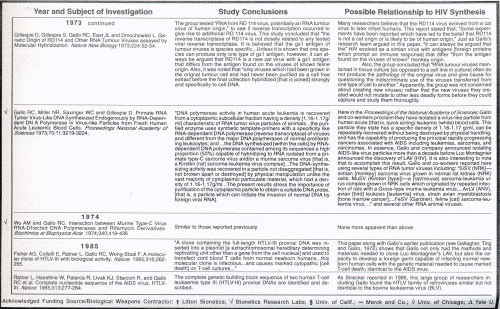
1971 continued
Gallo RC. Transfer RNA and Transfer RNA Methylation in Growing and "Resting" Adult and Embryonic Tissues and in Various Oncogenic Systems. Cancer Research 1971; 31 :621-629. / Human acute leukenia likely involves a block in leukocyte maturation due to a "disorder of protein synthesis." This is indicated by reduced DNA synthesis in cancerous cells and a build-up of heavy weight rRNA -- the assembly station for building amino acids into proteins -- in young leukemic cells. (The amino acids are delivered by tRNA to the rRNA, the ribosomal 'assembly station.') In this report, Gallo questioned whether acute lymphocytic leukemia was associated with a specfic change in tyrosyl-tRNA, and whether lymphosarcoma was related to a specific change in seryl-tRNA. "Similar to the results with RNA virus-transformed cells, the tumor derived trom the polyoma (mouse parotid tumor) cells showed higher tRNA methylase activity. / In this study, Gallo used several virus-transformed cells including the simian (monkey) virus (SV40) the murine (rat or mouse) sarcoma virus,and the polyoma (mouse parotid tumor) virus infected cells. At this time changes in specific amino acids within the white blood cells' RNA and DNA were being manufactured in the lab and studied to determine the related effects on the inmmune cell structure and function. Combine this research, and the available technology to isolate and inject genes from different viruses to produce a unique RNA retrovirus, and Gallo et. al., had all the requirements needed to produce HIV. The next questions are: 1) Did he attempt to combine different viruses to induce specific cancerous and immune system alterations, and 2) if so, which speciIc viral species and components might he have used to create an AIDS virus?
Gallo RC. Reverse Transcriptase, the DNA Polymerase of Oncogenic RNA Viruses. Nature1971;39;1:194-198. / Article reviews and updates knowledge regarding the importance of reverse transcriptase enzyme in cancer causing RNA tumor viruses. Important questions which Gallo proposed be researched including: "What are the detailed biochemical mechanisms for this enzyme?" and "Does the enzyme in viruses from higher forms ciffer from that of lower animals?" / None obvious in this summary report.
1972
Gallagher AE, Ting RC and Gallo RC. A Common Change of Aspartyl-tRNA in Polyoma- and SV40 Transformed Cells. Biochimica Et Biopnysica Acta 1972;272:568-582. / A major difference in aspartyl-tRNA (Asp-t-RNA) was demonstrated in polyoma (mouse parotid tumor) cells and SV40 (simian monkey tumor) cells. The "pattern of Asp-t-RNA is due to selective cellular gene expression," which "may be related to the function of the DNA oncogenic (cancer causing) virus genome (gene structure)" in infected cells. In addition, "a potential advantage of selecting virus-transformed tumor cells for study is that tRNA dilferences dscovered may be correlated with the virus genome function," with the ability to produce virus-related antigens and their effects. / In this study, Gallo and coworkers studed portions of different viruses to determine if "the tRNA difference (in cancer cells) be related to the properties of neoplasia (cancer development) in general, or, more specffically, to the function of the DNA oncogenic (cancer causing) virus genome (genetic code) inserted in the infected and transformed cells? They stated that "by studying viral or cellular mutants or cell segregants ...which have condtional variations in virus-specific celllular alterations, it should be possible to more precisely determine the bio- logical significance of the aspartyl-tRNA variation reported here." This work shows the analysis of different viral genes was underway to determine what effects each might have on developing cancer. They reported their desire to use this information on cancer causing viruses to fnd a cure for cancer, but at this time they applied their knowledge more towards creating various cancers and new viral species, than towards enadicating them.
Smith RG and Gallo RC. DNA-Dependenf DNA Polymerases I and II from Normal Human-Blood Lymphocytes. Proceedings of the National Academy of Sciences 1972; 69;10:2879-2884. / "A DNA polymerase has been found in blood lymphoblasts [immature white blood cells] from individuals with acute leukemia that, unlike lymphocyte DNA polymerases from normal indviduals, transcribes 70S viral RNA." / The 70S RNA virus is single stranded RNA retrovirus found in chickens which causes some prominent features of AIDS, including white blood cell dysfunction, sarcomas, progressive wasting, and death.
Robert MS, Smith RG and Gallo RC. Viral and Cellular DNA Polymerase: Comparison of Activities with Synthetic and Natural RNA Templates. Science 1972;176:798-800. / "Two DNA poIymerases purified from normal human lymphocytes (NHL) are distinguishable from the viral reverse transcriptases of avian [chicken] myeloblastosis virus and mason-Pfizer monkey virus by their relative affinity for select templates ...Criteria for dstinguishing the activity of viral reverse transcriptase are discussed," includng " ...the ability of viral reverse transcriptases, but not the cellular DNA polymerases, to react with purified single-stranded 70S RNA templates." Also: "The importance of using rigorously purified 70S RNA cannol be overemphasized. In early experiments, NHL DNA poIymerases I and II showed reactivity with feline (cat) leukemia virus (FELV) 70S RNA," however this was an artifact of contamination. "All of these distinguishing criteria will enable more critical determination to be made as to whether a viral-like reverse transcriptase is associated with neoplastic disease. The RNA-dependent DNA polymerase from human acute leukemic cells satisfies all these criteria for a reverse transcriptase. / This report also indicates Gallo and co-workers were evaluating single stranded RNA reverse transcriptase activity in cat leukemias as well as chickens. In 1982, Dr. Don Francis, a chief virologist at the CDC noted the "laundry list" of feline leukemia-like diseases and the sexual tranmissability of AIDS, and remarked, "Combine these two diseases -- feline leukemia and hepatitis -- and you have the immune deficiency.' The possibilities in relation to HIV synthesis and the implications of this study speak for themselves.
Acknowledged Funding Source/Biological Weapons Contract: (i) Litton Bionetics; (ii) Bionetics Research Labs; (iii) Univ. of Calif.; (iv) Univ. of Texas; (v) Univ. of Chicago; (vi) Yale U.
_______________
Notes:
[1] Germain RN. Antigen processing and CD4+ T cell depletion in AIDS. Cell 1988; 54:441-414.
[2] Herrera F. Adamson RH and Gallo RC. Uptake of transfer ribonucleic acid by normal and leukemic cells. Proc Nat Acad Sci 1970;67;4: 1943-1950. This paper was presented before the "International Symposium on Uptake of Informative Molecules by Living Cells, Mol, Belgium, 1970," the year in which $10 million in funds were appropriated by the Department of Defense for the development of AIDS-like viruses.
[3] Gallo RC, Perry S and Breitman RT. The enzymatic mechanisms for deoxythymidine synthesis in human leukocytes. Journal of Biological Chemistry 1967;242;21:5059-5068.
[4] Gallo RC and Perry S. Enzymatic abnormality in human leukaemia. Nature 1968;218:465-466.
[5] Gallo RC and Breitman TR. The enzymatic mechanisms for deoxythymidine synthesis in human leukocytes: Inhibition of deoxythymidine phosphorylase by purines. Journal of Biological Chemistry 1968;243;19:4943-4951.
[6] Gallo RC, Yang SS and Ting RC. RNA dependent DNA Polymerase of human acute leukaemic cells. Nature 1970;228:927-929.
[7] Gallo RC and Longmore JL. Asparaginyl-tRNA and resistance of murine leukaemias to L-asparaginase. Nature 1970;227:1134-1136.
[8] Department of Defense Appropriations For 1970: Hearings Before A Subcommittee of the Committee on Appropriations House of Representatives. Ninety-first Congress. First Session. H.B. 15090. Part 5. Research. Development. Test and Evaluation. Dept. of the Army. U.S. Government Printing Office, Washington, D.C., 1969.
[9] Gallaher RE, Ting RC and Gallo RC. A common change aspartyl-tRNA in polyoma and SV transformed cells. Biochimica Et Biophysica Acta 1972;272:568-582.
[10] Gallo RC, Sarin PS, Allen PT, Newton WA Priori ES, Bowen JM and Dmochowski L. Reverse transcriptase in type C virus particles of human origin. Nature New Biology 1971 ;232: 140-142; see also Gallo RC. Transfer RNA and transfer RNA methylation in growing and "resting" adult and embyonic tissues and in various oncogenic systems. Cancer Research 1971 ;31:621-29.
[11] Fujioka S and Gallo RC. Aminoacyl transfer RNA profiles in human myeloma cells. Blood 1971;38;2:246-252.
[12] Smith RG and Gallo RC. DNA-dependent DNA polymerases I and II from normal human-blood lymphocytes. Proceedings of the National Academy of Sciences 1972;69; 10:2879-2884.
[13] Bobrow SN, Smith RG, Reitz MS and Gallo RC. Stimulated normal human lymphocytes contain a ribonuclease-sensitive DNA polymerase distinct from viral RNA-directed DNA polymerase. Proceedings National Academy of Sciences 1972;69; 11 :3228-3232.
[14] Robert MS, Smith RG, Gallo RC, Sarin PS and Abrell JW. Viral and cellular DNA polymerase: Comparison of activities with synthetic and natural RNA templates. Science 1972; 176:798-800.
[15] Gallo RC, Abrell JW, Robert MS, Yang SS and Smith RG. Reverse transcriptase from Mason-Pfizer monkey tumor virus, avian myeloblastosis virus, and Rauscher leukemia virus and its response to rifamycin derivatives. Journal of the National Cancer Institute 1972;48;4:1185-1189.
[16] NCI staff. The Special Virus Cancer Program: Progress Report #8. Office of the Associate Scientific Director for Viral Oncology (OASDVO). J. B. Moloney, Ed., Washington, DC.: U.S. Government Printing Office, 1971, p. 22.
[17] Wu AM, Ting RC, Paran M and Gallo RC. Cordycepin inhibits induction of murine leukovirus production by 5-iodo-2'- deoxyuridine. Proceedings of the National Academy of Sciences 1972;69;12:3820-3824.
[18] Gillespie D, Gillespie S, Gallo RC, East J and Dmochowski L. Genetic origin of RD114 and other RNA tumor viruses assayed by molecular hybridization. Nature New Biology 1973;224:52-54.
[19] Gallo RC, Miller NR, Saxinger WC and Gillespie D. Primate RNA Tumor Virus-Like DNA Synthesized Endogenously by RNA-Dependent DNA Polymerase in Viruslike Particles from Fresh Human Acute Leukemic Blood Cells. Proceedings National Academy of Sciences 1973;70; 11 :3219-3224.
[20] Department of Defense Appropriations For 1970: Hearings Before A Subcommittee of the Committee on Appropriations House of Representatives, Ninety-first Congress. First Session. H.B. 15090, Part 5. Research. Development. Test and Evaluation. Dept. of the Army. U.S. Government Printing Office, Washington, D.C., 1969, p. 689.
[21] Committee on Human Resources. United States Senate. Hearings before the Subcommittee on Health and Scientific Research. Biological Testing Involving Human Subjects by the Department of Defense. 1977: Examination of Serious Deficiencies in the Defense Departments Efforts to Protect the Human Subjects of Drug Research. Washington, D.C.: U.S. Government Printing Office, May 8 and May 23, 1977, pp. 80-100.

